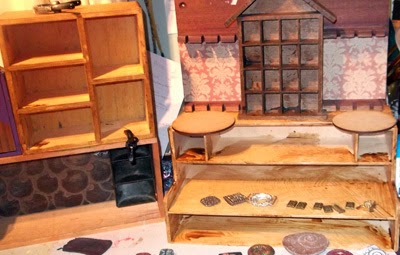Ceramics is full of surprises.
This week we experienced the joy of raku, the firing technique traditionally used in the Japanese Tea Ceremony, most often in the form of tea bowls.
As with everything in ceramics, the process takes time.
First you need to make a piece to be bisque fired which is an overnight process.
Then coat it with three layers of slip. When that is dry - a good day or so later - you then add the raku glaze.
And leave it to dry.
So I made my pot last week and put the slip and glaze on this week. On Wednesday, tutor Martin fired up the outside kiln and we stood like strikers round a brazier in the 3 deg C chill.
Heating the kiln takes a mere 30 minutes; and initially we had to put the fired items on the lid to encourage them to dry out more. When they were finally ready to be put in, the firing continued for another 30 minutes. Then came the really fun bit ...
.JPG)
No-one else wanted to volunteer to put on the helmet and gloves and it somehow fell to me. My role was to pour buckets of sawdust over the clay items once they had been removed by Martin (also dressed up and armed with tongs) and placed in a metal bin. The first addition took me by surprise as the sawdust burst into flames and sparked violently out of the bin.
.JPG) |
| My bisque fired pot, decorated with a fork |
.JPG) |
| Martin in charge |
.JPG) |
| Firing the kiln |
.JPG) |
| Like strikers round the brazier. |
.JPG) |
| Martin and me in the gear |
.JPG) |
| My pot at back in the kiln |
This continued for another 15 minutes or so as items were placed in the bin and I poured on more sawdust. Then the lid went on and guess what. Yes, come back the day after.
... the day after.
My blackened charred oval dish which I had thrown together in a hurry the previous week (and would shortly come to regret my haste) was retrieved from the bin. The next step was to chip away the slip, somewhat like scaling a fish, I should imagine. This is done for health and safety reasons over the extractor which sucks away the dust.
As I chipped, the dish broke. I was left with two pieces! It was only my first attempt so I wasn't disheartened, even though it then broke again, leaving me with a rim and several base pieces.
I had also not spread the initial layers of slip and glaze very competently - only patches of the opaque whiteness were visible amid the charcoal covering. But what did show through was intriguing enough for me to certainly have another go next year.
In the meantime I plan to do a 'Grayson Perry' with my raku bowl. He recently made a vase depicting shamed MP Chris Huhne (read more here)
http://www.independent.co.uk/arts-entertainment/art/news/grayson-perry-smashes-vase-portrait-of-chris-huhne-9810633.html
The vase was smashed and repaired using an ancient Chinese technique, where the cracks are repaired using lacquer resin dusted or mixed with gold. And that's
not quite exactly what I attempted. I do however have some Araldite (the goddess of repairs, says Martin) and some gold leaf. Here is the result ...
This final image is after I scrubbed away more of the charcoal residue.
.JPG)
.JPG)
.JPG)
.JPG)
.JPG)
.JPG)
.JPG)
.JPG)
.JPG)
.JPG)
.JPG)
.JPG)
.JPG)
.JPG)
.JPG)



.jpg)
.jpg)
.jpg)

.jpg)